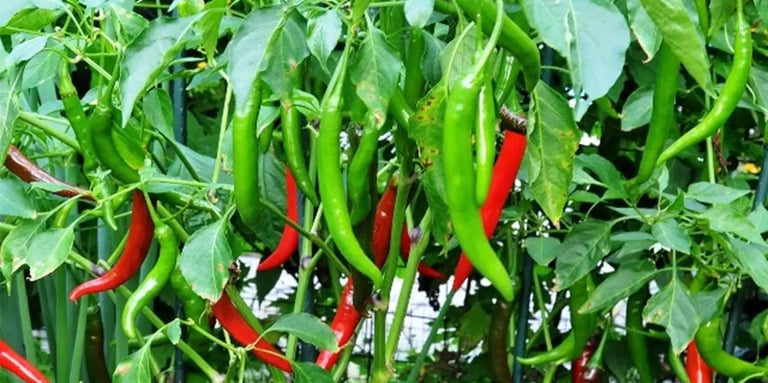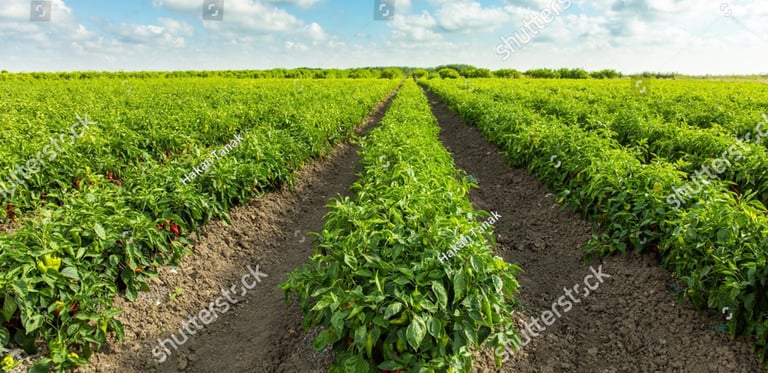Chilli Farming
It is the most valuable crop in Pakistan. The Chilli is used as a principal ingredient of various curries and chutneys, also used in vegetables, spices, condiments, sauces and pickles.
Chilli Farming
It is the most valuable crop in Pakistan. Pakistan is one of the Major chilli-growing countries. The Chilli is used as a principal ingredient of various curries and chutneys, also used in vegetables, spices, condiments, sauces and pickles. Pungency in chillies is due to the active constituent "Capsaicin", an alkaloid. The native home of chilli is considered to be Mexico with a second origin in Guatemala. Chilli was introduced in the subcontinent by the Portuguese in the middle of the 17th century and since then it had rapidly spread.
Capsaicin has many medicinal properties, especially as an anti-cancerous agent and instant pain reliever. It also prevents heart diseases by dilating blood vessels. Modern science has established nutritional values, comprising high levels of vitamins A and C, along with vitamins E and B1-3.
Soil
Chilli is grown in many types of soils including sandy to heavy clay. A fairly light fertile loam with a fair moisture holding capacity and well-drained are better-quality fruit producing than heavy soils. Chilli crop prefers a soil reaction ranging from pH 6–7.
Land preparation
Carry out ploughing 2-3 times and clod crushing after each ploughing. Add compost or Farm Yard Manure @15-20 tons/acre and mix well in the soil before sowing. Ridges and furrows may be formed at a spacing of 60cm. Apply 0.8 kg/acre of Azospirillum and 0.8 kg/acre of Phosphobacteria by mixing with 20 kg of FYM.
Nursery Preparation
Seedbeds of 3 m in length and 1.2 m wide may be prepared. The seedbed should be made 10-15 cm high from the ground. Rotten cow dung manure 20 kg plus 100 grams of superphosphate and 50 grams of potash should be added to the bed. Seeds may be sown in lines and the Distance from line to line may be 10-12 cm, and the distance from the plant to plant may be 5 cm. Seed depth should be 1-1.5 cm. Seeds should be covered by one centimetre-thick layer of cow dung manure and soil mixture.
In rainy days, the plants become transplantable in 4-6 weeks and in winter in about 8-10 weeks. The plant should be irrigated lightly before being uprooted from the nursery.
Transplantation
Transplanting of seedlings should be done in lines in the prepared field. For transplantation seedlings of 6-8 weeks old or 15-20 cm in height are selected. The distance from line to line should be 60 cm and the distance from the plant to plant should be 40 cm. Transplanting should be done in the evening. The field should be irrigated after transplanting.
Varieties
Key varieties grown in Pakistan are Longhi, Talhari, Gothki, Tatapuri, Narwala, and Qaisar and cover about 50% of the total area under chillies.
Other varieties are:- Kunri-1, Nageena, Mexi, Tall Round, Tall Pointed, Sanam, Hybrid P-6, Hybrid Sky Red and Hot pepper
Seed Rate
For local varieties use a seed rate of 200 gm/acre and for hybrids use 80-100 gm/acre.
Manures and Fertilizers
Farmyard manure at the rate of 12-15 tons/acre should be merged in the soil one month before seedbed preparation. Before transplanting 35-40 kg of phosphorus and 18 kg of nitrogen and 25 kg of potash per acre should be thoroughly mixed in the soil. This should be followed with a supplementary dose of 12 kg of nitrogen per acre at the time of fruit setting. Large application of nitrogenous fertilizers should be avoided as it increases vegetative growth and delays maturity.
Irrigation
The first water may be given immediately after sowing and transplanting. Afterwards, chillies are irrigated every week in summer. Within 15 days of transplanting, it is necessary to apply at least 2 to 3 irrigations for the setting up of the seedlings.
After that subsequent irrigations should be given at every 10 days intervals. Irrigation intervals can be increased or decreased according to climatic conditions.
Diseases
The chilli crop is prone to diseases which may become very destructive. Seed treatment, crop rotation, seed bed sterilization and fungicide/insecticide sprays, are general control measures that should be followed.
Damping-off:- It is very destructive to young seedlings, causing the stems to decay near the soil line. It can be kept under control by planting treated seeds in rows 4 to 6 inches apart in well-drained beds.
Viral Diseases:
Cucumber Mosaic Virus: CMV is transmitted by aphid vectors. Infected plants exhibit mosaic mottling, blistering, narrowing and deformation of leaves.
Chilli Leaf Curl: The virus is transmitted by a whitefly. Curling and yellowing of the leaves and severe stunting of the plants are characteristic symptoms. The leaves are greatly reduced in size with their margins curled upward giving them a boat shape.
Phytophthora Blight: The disease is regarded as a dark brown stem discolouration spreading upward from the soil line accompanied by a sudden wilt of the entire plant without foliar yellowing.
Control
All the infected plants should be removed from the crop.
Spray suitable insecticides for the control of aphids.
The collar-rot incidence can be reduced by growing plants on ridges that provide good drainage.
Controlled irrigation can reduce the chance of the disease’s spread. Care should be exercised so that water should not run over the ridges and touch the base of the plant.
A crop rotation cycle of at least 3 years should be followed. The scheme should not include tomato, brinjal, cucurbits and bean as these are also prone to the pathogen.
Harvesting
For drying, chillies should be picked when fully ripe and red in colour. After picking the chillies should be spread out in a thin layer on mats in the sun for drying. Care should be taken not to pile up freshly harvested crop for a long time, as this is apt to rot.




